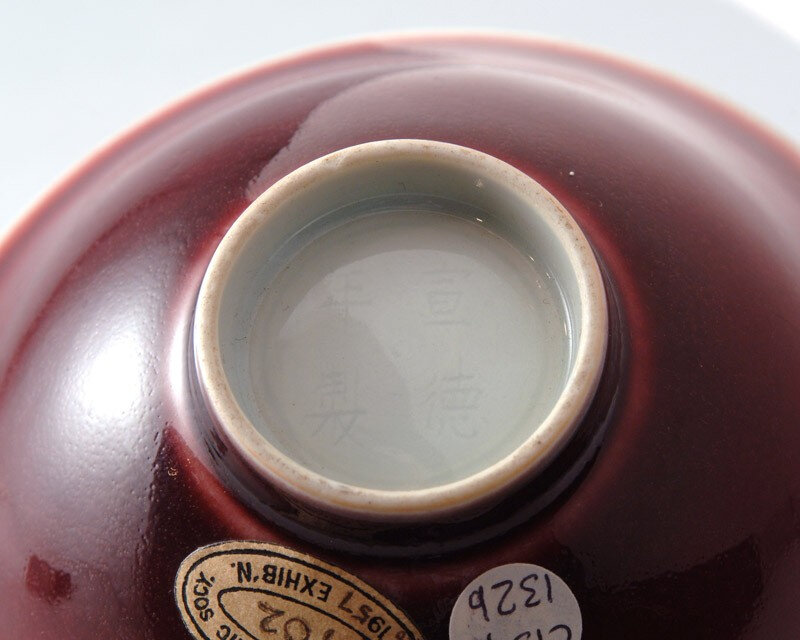A rare red-glazed bowl, Qing dynasty, Kangxi period (1662-1722)
Lot 507. A rare red-glazed bowl, Qing dynasty, Kangxi period (1662-1722). Diameter 4 7/8 in., 12.4 cm. Estimate US$20,000 — 30,000. Lot sold 43,750 USD. Courtesy Sotheby's.
the deep rounded sides rising from a tapered foot to a slightly flared rim, covered overall in a vibrant rich copper-red glaze thinning to white at the rim, the base reserved in a white glaze with a bluish tint, incised with an apocryphal four-character Xuande mark.
Bluett & Sons., Ltd., London, 22nd October 1934.
Collection of Alfred (1873-1950) and Ivy (1890/1-1976) Clark.
Sotheby's London, 25th March 1975, lot 143.
Exhibited: International Exhibition of Chinese Art, Royal Academy of Arts, London, 1935, cat. no. 1513.
Exhibition of Chinese Art, City Art Gallery, Manchester, 1936, cat. no. 303.
Note: The present bowl was originally one of a pair, sent by K.K. Chow to Bluett's in London on commission in the 1930s. One bowl was sold to Alfred and Ivy Clark, and the other to Sir Alan Barlow (1881-1968) and is today in the Ashmolean Museum, Oxford, illustrated in Michael Sullivan, Chinese Ceramics, Bronzes and Jades in the Collection of Sir Alan and Lady Barlow, London, 1963, pl. 132b. At the time, the pair was considered 'Xuande mark and period', and both bowls were exhibited and published as such; the present bowl in the 1935 Royal Academy exhibition; and the Barlow bowl in the exhibition of Monochrome Porcelain of the Ming and Manchu Dynasties, Oriental Ceramic Society, London, 1948, cat. no. 73; and in The Arts of the Ming Dynasty, Oriental Ceramic Society, London, 1957, cat. no. 102. By the 1975 auction in our London rooms, Important Chinese Ceramics from the Clark Collection, the present bowl had been re-attributed to the Kangxi period.
Sotheby's. Important Chinese Art, New York, 20 march 2019

/https%3A%2F%2Fprofilepics.canalblog.com%2Fprofilepics%2F1%2F0%2F100183.jpg)
/https%3A%2F%2Fstorage.canalblog.com%2F03%2F02%2F119589%2F96711876_o.jpg)
/https%3A%2F%2Fstorage.canalblog.com%2F11%2F31%2F119589%2F94773502_o.jpg)
/https%3A%2F%2Fstorage.canalblog.com%2F20%2F83%2F119589%2F94772815_o.jpg)
/https%3A%2F%2Fstorage.canalblog.com%2F26%2F72%2F119589%2F75604929_o.jpg)
/https%3A%2F%2Fstorage.canalblog.com%2F59%2F60%2F119589%2F26458628_o.jpg)






/image%2F1371349%2F20240416%2Fob_65a1d8_telechargement-31.jpg)
/image%2F1371349%2F20240331%2Fob_7209d9_117-1.jpg)
/image%2F1371349%2F20240324%2Fob_64049b_1.jpg)
/image%2F1371349%2F20240324%2Fob_a0994e_1.jpg)